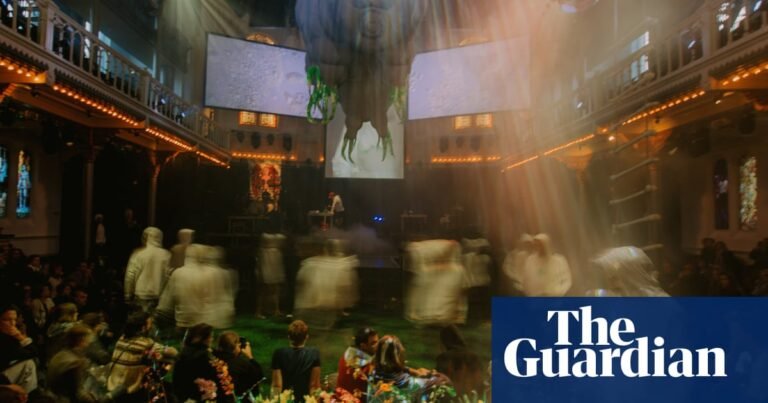Naked performers covered in paint roll around atop dirt and foliage. Menacing sculptures hang from the ceiling and walls. The costumes have a beastly quality. At one point, a stream of feathers are strewn across the stage; at another, pink petals float down from above. This is Trance, an immersive psychedelic experience inspired by an eclectic mix of influences from electronic music and rave culture to Buddhism, cartoons and Japanese Butoh dance theatre.
When 39-year-old Chinese artist and director Tianzhuo Chen first had the idea for Trance in 2019, it was to accompany a solo exhibition of his work at M Woods Museum in Beijing. The initial result was a three-day performance with each fraction spanning 12 continuous hours. It has since been whittled down to a single 12-hour-long production. This month, the show is on in London as part of the Southbank Centre’s ESEA Encounters, a series celebrating east and south-east Asian arts and culture.
It will serve as somewhat of an artistic homecoming for Chen, who did his undergraduate and master’s degrees at Central Saint Martins and Chelsea College of Arts, respectively. “London definitely influenced a lot of the club part of it,” he says over video call, dressed in a simple black T-shirt and clear-frame glasses. “When I was living in the UK, I was pretty young and I experienced a lot of its club culture.” Since graduating in 2010 (and returning to China for some years after), he has made a name for himself by bringing the sacred and the subcultural together.
Watch a taster for Trance
In 2015, Chen founded the music-art-dance collective Asian Dope Boys, which earned a cult following for shows resembling both religious ceremonies and avant garde techno parties. In 2018, 20 members toured Europe performing at venues including London’s Barbican, the Palais de Tokyo in Paris and Säule, an experimental space at Berlin’s iconic club Berghain.
He has lived in Berlin for the last three years. In 2024, at the city’s HAU performance space, Chen premiered Ocean Cage, a video and performance piece inspired by stories from Lamalera. The fishing village in Indonesia is one of the last communities in the world where traditional whale-hunting still exists – the locals relying on it for both sustenance and as part of their spiritual beliefs. “Because it’s a volcano island, it doesn’t grow anything, so they have to go whaling for their survival,” he says, explaining that they believe that their ancestors were reborn as whales in order to feed the village.
With Trance, Chen wanted to bring people from different disciplines together. “Musicians, performers, professionals, non-professionals, all of it,” he explains. Six years on, the genre-bending theatre-rave has been performed around the world. The latest version can be divided into six two-hour chapters, each reflecting on Buddhist themes, especially the idea of reincarnation, which in its cosmology has six realms: gods, demigods, humans, animals, hungry ghosts and hell. “In the beginning, they are performing from an image of hell,” he says of a sequence also referencing a series of 15th-century Japanese paintings that explore the different stages of death. “A beautiful woman dies, her rotting corpse is eaten by dogs and becomes dust at the end,” he says. For him, the first chapter feels particularly meditative. “It comes from the Buddhist idea of how you treat your body, and that there is nothing left other than flesh when you die.”
Sharing the moment … Trance. Photograph: Pierre Zylstra
By the final chapter, Trance shifts into what Chen calls a “collective rave” and takes a more optimistic turn. “The last part is the most human; everyone is dancing on their own,” he says. “It’s the part most strongly related to club culture, to dancing, to the expression of the individual.” It’s also the point in the performance when those watching get most involved. “So much of it is sharing the moment with the audience,” making them a part of “this ritual and ceremony, a healing and cleansing-type moment”.
Trance does not follow an explicit narrative, allowing it to evolve as it moves through continents and venues. “It’s a little bit site-specific, as the stage never looks the same,” he says. He points out that some venues are well-equipped, some offer outdoor space, and some are simply dilapidated buildings. But, as a result, he never gets tired of showing it. “Little changes and different conditions keep this work progressing because it has to,” he says. At the Southbank Centre, “we are creating a special design for it, and we are using their big theatre room to screen Ocean Cave”.
Ritual and ceremony … Trance. Photograph: Pierre Zylstra
He has also invited the Japanese dubstep musician Takeaki Maruyama, known professionally as Goth-Trad, to perform. “I went to a lot of dubstep parties when I was in London before some of the legendary dubstep clubs closed down, so now feels like the time to embrace it,” says Chen.
It’s not every theatre production that can also double as a 12-hour rave. “I get a lot of feedback,” says Chen. “People say it’s the best performance ever … they feel healed, they feel cleansed, they cried, all these feelings. And then some people really don’t like it! All this strong emotion is what I appreciate. You don’t have to understand the story or have any background knowledge – how you emotionally relate and connect with the piece is the most important thing to me.”
Tianzhuo Chen: Trance is at Queen Elizabeth Hall Foyer, London, on 18 July as part of the Southbank Centre’s ESEA Encounters season, which runs 17-20 July

